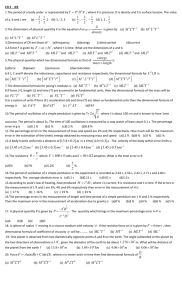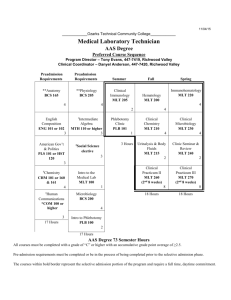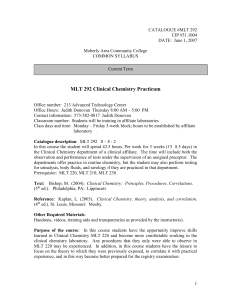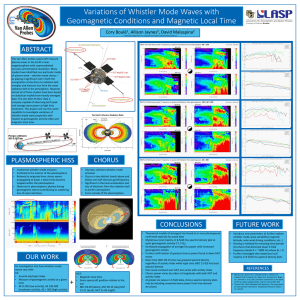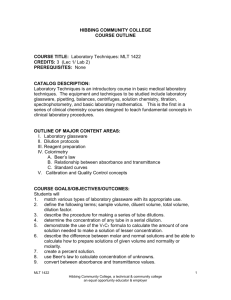A IO N Io
advertisement
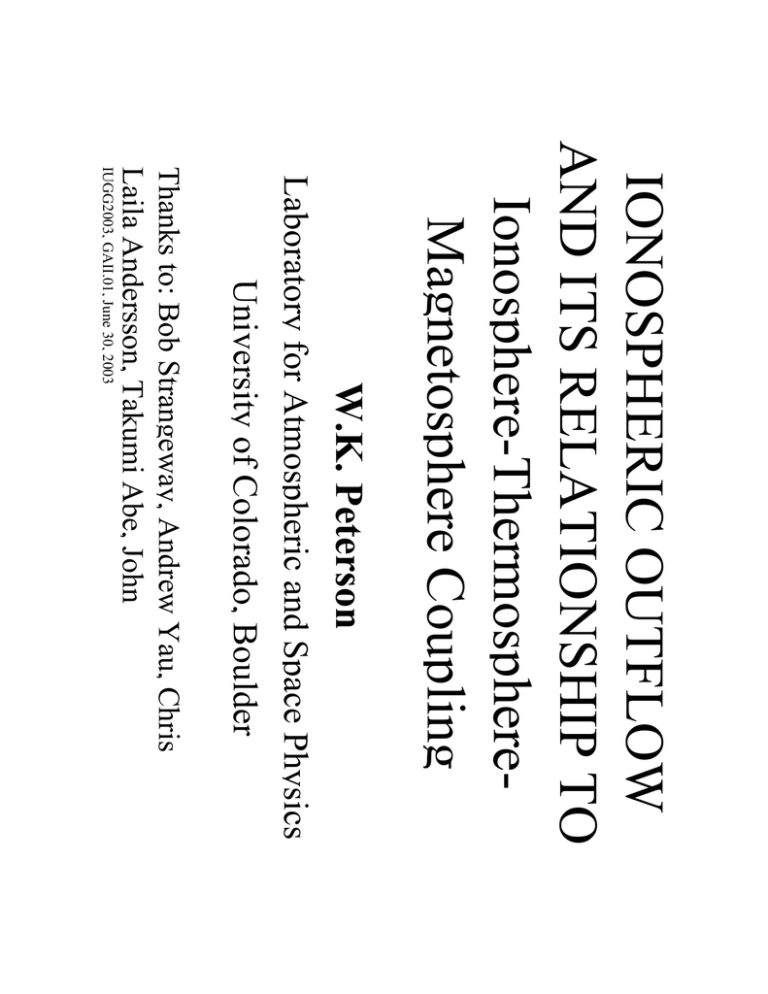
IONOSPHERIC OUTFLOW AND ITS RELATIONSHIP TO Ionosphere-ThermosphereMagnetosphere Coupling W.K. Peterson Laboratory for Atmospheric and Space Physics University of Colorado, Boulder Thanks to: Bob Strangeway, Andrew Yau, Chris Cully, Laila Andersson, Takumi Abe, John IUGG2003, GAII.01, June 30, 2003 Foster Topics • Plasma outflow is a minor player in the energetics of coupling between the ITM region and the Magnetosphere • Ion outflow does not follow directly from Joule heating. - There are a significant lag time and additional high altitude process required before outflow can begin.is not outflow • Upflow • Thermal O+ permeates the magnetosphere even in times of low - Energetic O+ can appear in the magnetosphere rapidly in response activity. to geophysical events. - The plasmasphere is important for He and O storage and release + + • We are just beginning to obtain reliable information on what conditions in the topside ionosphere are associated with ion outflow. M/I-T Coupling •The strongest and most important component of M/I-T coupling is through large scale field-aligned currents. •The plasma outflow response is energetically weaker •We are interested in plasma outflow because we expect that outflow from the I-T could be an important feedback mechanism acting in the magnetosphere Ion outflow does not follow directly from Joule - There are a significant lag time and additional high altitude heating. energization required before outflow can begin. Exobase => 300 km and many meanpaths free below => Most of what goes up doesn't go out Velocity required to reach the plasma sheet ~ 10 km/s ( < 1 eV H+ -- 2 eV He + -- 10 eV O + -- 20eV NO +) Typical velocity in topside ionosphere << 1 km/s (up and down!) Extreme (Kp =9) velocity in topside ionosphere < 3 km/s Lockwood and Titheridge GRL, 1981 et al. JGR 1991 Loranc Inferred upward flux radars is from typically orders of magnitude less than the actual escaping flux Escape velocity is acquired above 1000 km through a variety of processes •Upflowing thermal plasma moderate acquires energies in the polar cap and plasmasphere. •Thermal plasma is significantly energized on auroral and cusp field lines. O + He + 0 H + 10 Abe, JGR, 1993 20 + 0 H + 15 km/s 6000-9000 km Kp ≤ 2+ 3- ≤ Kp≤4+ Kp ≥ 5- Yamada, 200 1 •Day-night asymmetry in velocity. •Auroral and cleft O+ contribution. + Thermal Ion Outflow: Akebono SMS Observations O He 900 0 500 0 100 0 -10 Velocity (km/s) •Polar-wind-like flow characteristics. •Temporal-spatial variations associated with local ionospheric conditions. Altitude <1 eV 1 8 50 ° 6 2.5-5 eV Inferred Ionospheric Source of O+ ions Observed on Akebono 1 2 0 1-2.5 eV >5 eV Ionospheric source location of thermal-energy (<1 to >5 eV) O+ ions observed on Akebono Energization on auroral field lines is structured mostly in latitude From Dynamics Explorer 1 Transverse energization of ions (i.e. the formation of ion conics) occurs over extended altitude regions on auroral field lines. The "conic" angle folds up more slowly at higher altitudes than expected from the … adiabatic invariant contour s Σ Kp F 7 10. UFI Flux Seasonal Variation: Winter/summer ratio He+: ~ 2.5 O+ : > 1 nightside <1 dayside H+ ~ 1 Solar-cycle Variation: Solar-max/solar-min ratio: H+ : ≤ 1+:> O 1 UFI flux distribution above 6000 km altitude observed on POLAR TIMAS from Winter 1996 to Winter 1998 (Peterson et al., JGR, 2001) O+ H+ H+ O+ O+ Ref. Yau et al., 1988 Ds t Kp Energetic Upflowing Ion Outflow Rates: DE1/EICS H+ A O+ NOTE: The Flow is NOT E ZERO at minimum activity H+ F 10. Kp 0 ∅ 6: 20-fold7 O+ and 4-fold H+ increase; Solar min ∅ max: 10-fold O+/ H+ increase; Thermal O permeates the + magnetosphere even in times of low activity. •Significant, measurable, fluxes of O+, H+ and He+ acquire escape velocity even during intervals of low geomagnetic activity. •O+ in the magnetosphere doesn't have to come directly from the ionosphere in response to geophysical events. •The plasmasphere is important for He+ and O+ storage and release + + + Plasmaspheric storage and release of H , He and O Some, not all, of the intensehave events detectable in the top signatures side ionospher e Observation of Plasmaspheric He+ leaking from the magnetosphere into the cusp/magnetosheath from Polar . R/RE ~ 5 MLT 11:30 H+ down flowing < 500 eV He+ mode not compatible with this display O+ < 500 eV Upflowing He+ drifting across field lines into the cusp/magnetosheath This is a rare event. It's the only one I've found in the Polar/TIMAS data set. Effects of Low-energy Ion Outflow in the Central Plasma Sheet Simulated fluxes of ionospheric H+ and O+ ions FROM Akebono TO the plasma sheet boundary at low Kp (Cully et al. 2003b) What determines magnitude and location of ion ouflow • We are just beginning to systematically investigate • Local Correlations this. - Strangeway, Su • Global Correlations - Cully/Yau, Moore • Boundary Correlations - Andersson/Peterson Local Ion Flux vs Poynting Flux From FAST Strangewa y Yosemite , 2003 . Observations Outflow Connections F -Normalized net and upward fluence (i.e. 10.7 effects of F removed) vs. solar wind 10.7 From Akebono < 9000 km Cully et al., parameters 2003a 10.7 clock clock Stepwise multiple regression to distinguish "independent" between and "dependent" correlations "Independent" (robust) parameters: - EUV flux F - velocity latitude V lat - pressure p - IMF variability σB ,φ - KE flux Φ KE - IMF clock angle cosine cos (θ V-B "Dependent" (non- cone ) Global Thermal Fluence: Dependence on Solar-Wind Parameter s • • • parameters: robust ) long - Kp, Dst, B , n, - σV, E2, V IMF ,φ ,θ Correlations of outflow with magnetospheric boundaries •FAST data for 1997 •Polar cap boundary identified from electrons •Equatorward boundary identified from ion loss cone signatures •Scale mass resolved H+/O+ upflowing fluxes observed between boundaries into a constant latitude width auroral zone and accumulate the data. •Preliminary results presented here: Oxygen Flux-1 Invariant Latitude Kp < 2 18 MLT 18 MLT 12 MLT 12 MLT 12 MLT 12 MLT 18 MLT Altitude 1500-3100 km Kp > 2 18 MLT 12 MLT 12 MLT 3100-3800 km 12 MLT 12 MLT 18 MLT 18 MLT >3800 km 12 MLT 12 MLT 12 MLT 12 MLT 6 MLT 6 MLT 30 0 0 3x107 3x106 3x105 30 0 0 3x107 3x106 3x105 in each pixel (s cm2)(s cm2)-1 Particle Flux in each pixel Number of events 1 Particle Flux Number of events The net total particle flux, where the downward loss cone flux is subtracted Flux Kp > 2 Kp < 2 18 MLT 18 MLT 12 MLT 12 MLT 12 MLT 12 MLT 18 MLT Altitude 1500-3100 km Oxygen 18 MLT 12 MLT 12 MLT 3100-3800 km 12 MLT 12 MLT 18 MLT 18 MLT 12 MLT 12 MLT 30 0 0 3x107 3x105 30 0 0 3x107 3x105 in each pixel (s cm2)(s cm2)-1 Particle Flux in each pixel Number of events 1 Particle Flux Number of events >3800 km 12 MLT 12 MLT 6 MLT 6 MLT The net total particle flux, where the downward loss cone flux is subtracted Kp < 2 18 MLT 18 MLT 12 MLT 12 MLT 12 MLT 12 MLT 18 MLT 18 MLT 12 MLT 12 MLT 3100-3800 km 12 MLT 12 MLT 18 MLT Altitude 1500-3100 km Kp > 2 Preliminary Oxygen Mean Energy (eV) 18 MLT >3800 km 12 MLT 12 MLT 12 MLT 12 MLT 6 MLT 6 MLT 30 0 0 3x102 0 30 0 0 3x102 0 in each pixel Anti-Earthward (eV) Characteristic energy in each pixel Number of events Anti-Earthward (eV) Characteristic energy Number of events Conclusion s • Some of the thermal plasma that goes up from the ionosphere gets energized and makes it into the magnetosphere • What? When? Where? Why? and How? are still good questions to ask. • Thermal O permeates the + magnetosphere and doesn't have to come directly from the ionosphere in response to geomagnetic events Backup slides follow x THERMAL ESCAPE. The classic example of an escape process for light gases is thermal or Jeans escape, formulated in 1904 (13, 14). The basic idea is that, above some critical level now usually called the "exobase," atoms in the high-velocity tail of the Maxwellian distribution must escape if they are directed upward at or above the escape velocity, which is 11.2 km/s for Earth. The exobase level is 500 to 600 km for Earth. Thermal escape generally explains the observation that only the most massive bodies in the solar system have dense atmospheres, and also that atmospheres are generally deficient in light atoms such as H and He (except in the Jovian planets). It does suggest that heavy gases, and possibly even N, should be stable on our moon, and at the beginning of this century the lack of a substantial lunar atmosphere was a stumbling block to the acceptance of the Jeans equation. Of course, the objection vanishes if the moon never had such an atmosphere. Other loss processes probably dominate, at least currently. The ionosphere/thermosphere is coupled to the magnetosphere by large scale field aligned currents, ion outflow, and plasma waves. The temporal and spatial scales of these processes and their coherence are not fully understood. Large scale field aligned currents are closed deep in the region of the thermosphere/ionosphere where collisions Between neutral particles dominate. The energy deposited by Joule heating is transported slowly upward at thermal velocities. Ion outflow originates high in the thermosphere/ionosphere in the transition region (i.e. exobase) where collisional and transport processes are of comparable importance. In this region typical thermal velocities are significantly below the ~10 km/s escape velocity determined by Earth's gravity; nevertheless a significant flux of ions escapes into the magnetosphere. The composition of ions escaping into the magnetosphere is completely different from the composition of the exobase (transition region). Different mass dependent mechanisms provide the additional energy needed for ion escape in the polar wind, cleft ion fountain and auroral acceleration region. Interpretations of satellite observations of escaping ions made from satellites are further complicated by storage and episodic release of significant quantities of He+ and O+ from the plasmasphere. Some investigators have suggested that inhomogeneities in the mass density in the Earth's magnetotail are triggers for magnetospheric substorms, which, in turn, result in significant intensifications of Joule heating. In this paper we will review how the observations of escaping ions have been used to unravel some of the parts of this complex coupled system. Ion Outflow Control - Summary Dayside averages of particle and field fluxes show that ion outflows are correlated with: • DC Poynting flux • Precipitating electron density • Alfvén wave Poynting flux ELF waves are also correlated, but their effects can be assumed into other parameters. Point by point correlations show that: • Dayside: DC Poynting flux is better than electron density (!) • Nightside: Electron precipitation is better • Alfvén waves seem to show greater control as fluctuating fields (RMS), than than net Poynting flux. Ion Flux v Electron Density Outflow Connections - 1
